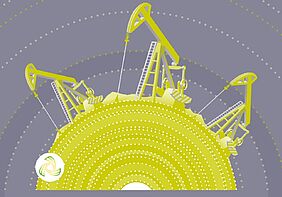Aenert news. Invention analysis
Previously, we published articles concerning chemical stimulation (18.04.2022), gas injection or water flooding (09.05.2022), and steam injection (06.08.2022) technologies used in unconventional oil production, and, specifically, about Steam-assisted gravity drainage approach (06.12.2022).
Now we will consider a group of inventions disclosing technical solutions in the field of steam generation for unconventional oil production, including generation of steam on the ground and downhole steam generation. More than 1600 patent documents published in the twenty-year period from 2002 to 2021 were selected for the present review by using Advanced Energy Technologies methodology.
The collected documents were published in 33 patent offices of the world by 414 applicants from 22 countries.
Unconventional oil. Steam generators. Relationship of number of applications to total number of documents by year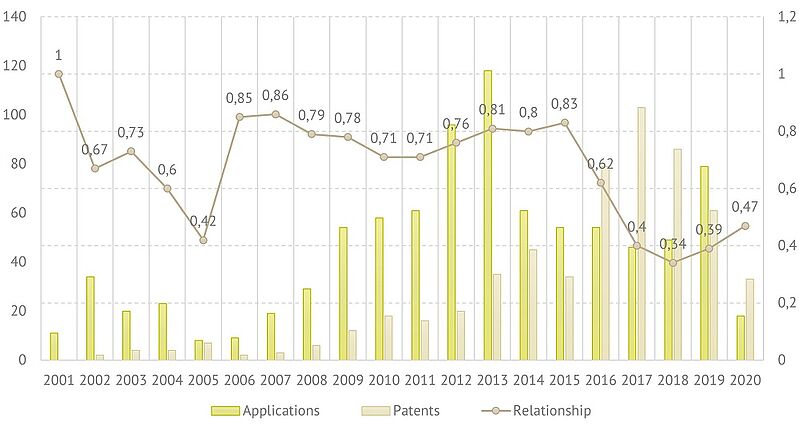
The chart above shows that starting from 2013 there was a rapid growth in the number of published patent applications, which led to a spike in the number of granted patents in 2017-2018. The growth was followed by a decline in both the number of patents and applications in recent years. Since 2018 the number of start documents not belonging to any previously-formed patent family was growing from 28% to 77%. In recent years, there was a decline in annual appearance of new applicants and new IPC subgroups assigned to the patent documents. The number of new patent offices appearing in the collection of documents in the last years is also insignificant. This indicates that the most noticeable phase of development in this area of technology took place in 2014-2016, although the ongoing activities show that there still is a room for development.
Almost 32% of all collected patents published between 2002 and 2021 were granted by the USPTO (US) patent office. It is followed by CNIPA (CN) with more than 21% and CIPO (CA) with around 19% of the collected patents. Similar picture can be seen in the collection of patent applications registered in the past 5 years, excluding that CNIPA (CN) was in the lead in this case: CNIPA (CN) – about 29%, USPTO (US) – about 23%, and CIPO (CA) – nearly 14%.
Unconventional oil. Steam generators. Breakdown of inventions by patent offices. Patents, 2002-2021 (left); Applications, 2017-2021 (right)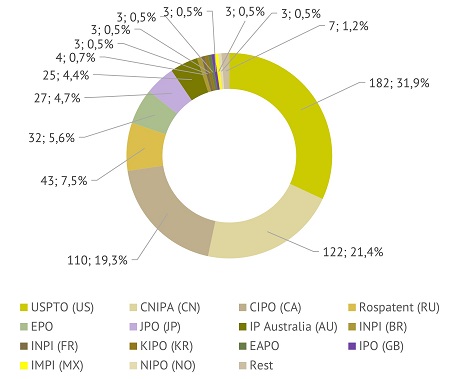
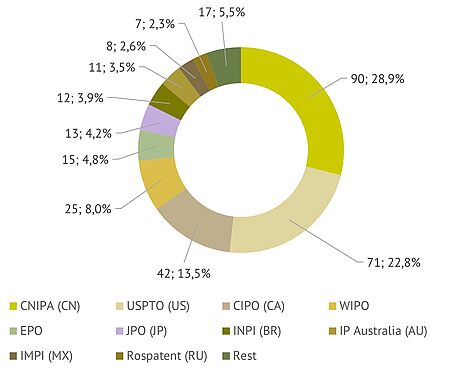
Residents of the United States were leading by the number of patents issued during the 20-year period with a share of almost 56% of all cases. High patenting activity was also demonstrated by residents of Canada and China. For patent applications published in the past five years, the leaders were the residents of the United States, China, and Canada, with the shares of nearly 55%, 23%, and 16%, respectively.
Following is a list of top 10 applicants for patents published in the 20-year period:
Unconventional oil. Steam generators. Top applicants. Patents, 2002-2021
| Status | Country | Name | Average rating | Total 2002-2021 |
|---|---|---|---|---|
| Company | US | ExxonMobil Upstream Research Company | 18 | 118 |
| Company | US | General Electric | 17.9 | 59 |
| Company | NL | Shell Internationale Research Maatschappij B.V. | 18.8 | 25 |
| Company | US | Halliburton Energy Services, Inc. | 19.1 | 20 |
| Company | US | ConocoPhilips Company | 16 | 19 |
| Company | US | World Energy Systems Inc | 16.8 | 15 |
| Company | SA | Saudi Arabian Oil Company | 14.4 | 13 |
| Company | US | Veolia Water Technologies, Inc. | 14.5 | 13 |
| Company | US | Glasspoint Solar, Inc. | 14.9 | 11 |
| Company | CA | Imperial Oil Resources Ltd. | 16 | 10 |
Among all of the applicants participating in the selection of documents under consideration, ExxonMobil Upstream Research Company (US) had the highest Market involvement ratio for patents published during the 20-year period – about 16% (Market involvement ratio = volume ratio multiplied by ownership ratio, where Volume ratio - share of applicant documents in total number of documents, Ownership ratio - applicant's participation share in total number of documents). It was followed by General Electric (US) (nearly 6%) and Shell Internationale Research Maatschappij B.V. (NL) (more than 4%). In the collection of recent applications, the top three applicants in this respect were ExxonMobil Upstream Research Company (US) – almost 11%, Glasspoint Solar, Inc. (US) – nearly 6%, and XDI Holdings, LLC (US) – about 5%.
Unconventional oil. Steam generators. Top applicants. Applications, 2017-2021
| Status | Country | Name | Average rating | Total 2017-2021 |
|---|---|---|---|---|
| Company | US | ExxonMobil Upstream Research Company | 13 | 41 |
| Company | US | Glasspoint Solar, Inc. | 10.1 | 18 |
| Company | US | XDI Holdings, LLC | 7.4 | 16 |
| Company | US | Ecolab USA Inc. | 9.4 | 15 |
| Company | US | General Electric | 13.5 | 13 |
| Company | CA | Cenovus Energy, Inc. | 12.1 | 9 |
| Company | US | ConocoPhilips Company | 11.8 | 9 |
| Company | US | Veolia Water Technologies, Inc. | 8.9 | 9 |
| Company | CN | CNPC China National Petroleum Corporation | 11.8 | 8 |
| Company | US | Hexion Inc. | 5.8 | 8 |
In the collection of patent documents describing technologies of steam generation for enhanced oil recovery, the most commonly mentioned problems were Energy, gas or water consumption, Low efficiency of primary production, and Environmental balance and protection. Generally, in patents and patent applications the authors presented their ideas in the form of methods and devices. The number of inventions disclosing new compositions is much smaller. The most popular IPC subgroups assigned to the patents selected for the present review are E21B43/24 (using heat, e.g. steam injection), F02C3/34 (with recycling of part of the working fluid, i.e. semi-closed cycles with combustion products in the closed part of the cycle), C02F1/04 (by distillation or evaporation), E21B36/00 (Heating, cooling, or insulating arrangements for boreholes or wells, e.g. for use in permafrost zones), and E21B43/40 (Separation associated with re-injection of separated materials).
In the collection of documents under consideration, the largest patent families comprise 45, 35, and 27 patent documents and are represented by core documents CA2692686C, US10100741B2, and CA2605729C, respectively (Core document is a base document for which a complete description of the invention is available in generally-accessible patent databases):
PRODUCING RESOURCES USING HEATED FLUID INJECTION / P: CA2692686C / IPC: E21B34/08, E21B36/02, E21B43/24 / CAVENDER TRAVIS W, SCHULTZ ROGER L / HALLIBURTON ENERGY SERVICES, INC. / Appl. date: 30/06/2008; Publ. date: 06/08/2013 / Canadian Intellectual Property Office / Core document: CA2692686C / Technology categories: HO / Technology elements: CS, DDH, ISC, RPIE, STI, STd / Problems: EGWC, HCRR, LEPP / Technical solution types: D / Claims: 16 / Rating: 19
System and method for diffusion combustion with oxidant-diluent mixing in a stoichiometric exhaust gas recirculation gas turbine system / P: US10100741B2 / IPC: F02C7/22, F02C1/00, F02C1/08, F23C9/08, F23D14/58, F23R3/28, F02C3/34, F23K5/00, F23L7/00, F23C9/00, F23R3/40, F23D14/20, F23R3/34, F23D14/22, F02C3/30 / Huntington Richard A, Dhanuka Sulabh K, Slobodyanskiy Ilya Aleksandrovich / General Electric Company, ExxonMobil Upstream Research Company / Appl. date: 30/10/2013; Publ. date: 16/10/2018 / United States Patent and Trademark Office / Core document: US10100741B2 / Technology categories: UGT / Technology elements: GWF, STI, STcs, STs / Problems: EBP, UP / Technical solution types: D, M / Claims: 19 / Rating: 19
IN SITU CONVERSION PROCESS UTILIZING A CLOSED LOOP HEATING SYSTEM / P: CA2605729C / IPC: E21B43/24, E21B36/00 / FOWLER THOMAS DAVID, SANDBERG CHESTER LEDLIE, SCHOEBER WILLEM, VINEGAR HAROLD J / SHELL INTERNATIONALE RESEARCH MAATSCHAPPIJ B.V. / Appl. date: 21/04/2006; Publ. date: 07/07/2015 / Canadian Intellectual Property Office / Core document: CA2605729C / Technology categories: OSH, OSN / Technology elements: RPIE, STI, STcs, STd, STem, STot, UTR / Problems: HCG / Technical solution types: D, M / Claims: 16 / Rating: 19
The following abbreviations are used in the documents hereinbefore and hereinafter: C - Composition; D - Device; M - Method; OSN - Oil sands; OSH - Oil shale; HO - Heavy and extra heavy oil; UGT - Unspecified or general technologies; CS - Chemical stimulation; DDH - Directional drilling or hydraulic fracturing; GWF - Gas injection or water flooding; ISC - In-situ combustion; RPIE - Reservoir permeability improvement and extraction; STcs - Steam injection & chemical stimulation; STd - Downhole steam generation; STem - Equipment and materials for drilling and steam injection; STgd - SAGD; STI - Steam injection; STot - Other steam treatment approaches; STs - Surface-generated steam; STwp - Waste processing in steam stimulation; UTR - Uncommon thermal recovery; EBP - Environmental balance and protection; EGWC - Energy, gas or water consumption; HCG - High capital or running costs in general; HCRR - High running costs of repair and replacement; HRCM - High running costs of maintenance; LEPP - Low efficiency of primary production; UP - Unclear problem.
Unconventional oil. Steam generators. Breakdown of documents by family size. Patents and applications, 2002-2021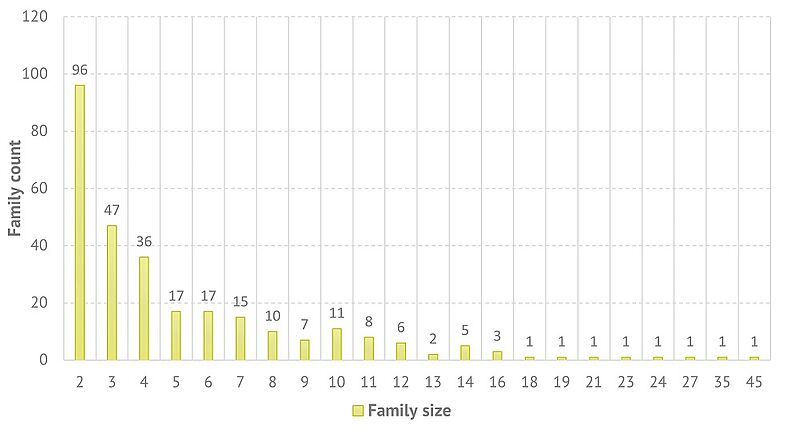
Following are several examples of patent documents having the highest rating calculated using Advanced Energy Technologies methodology, from the collection of documents describing steam generation technologies for unconventional oil recovery:
Unconventional oil. Steam generators. Prominent patent documents by rating, 2002-2021:
BLOWDOWN STREAM FILTRATION TECHNIQUES FOR STEAM GENERATION IN THERMAL IN SITU HYDROCARBON RECOVERY OPERATIONS / P: CA2894179C / IPC: E21B43/40, E21B43/24 / PERNITSKY DAVID, BHATTACHARJEE SUBIR, HURWITZ GIL / SUNCOR ENERGY INC. / Appl. date: 11/06/2015; Publ. date: 27/11/2018 / Canadian Intellectual Property Office / P/A pair: CA2894179A1 / Technology categories: HO, OSN / Technology elements: STI, STgd, STs, STwp / Problems: EGWC, HRCM / Technical solution types: C, D, M / Claims: 144 / Rating: 21
用于保护具有排气再循环的气体涡轮发动机中的组件的系统和方法 (en: System and method for protecting components in a gas turbine engine with exhaust gas recirculation) / P: CN105189940B / IPC: F01D25/30, F02C7/18, F02C3/34 / P·K·比亚尼, R·萨哈, A·K·达索基, R·A·亨廷顿, F·F·米特瑞克 / 埃克森美孚上游研究公司 / Appl. date: 10/01/2014; Publ. date: 15/08/2017 / National Intellectual Property Administration / Core document: US9581081B2 / Technology categories: UGT / Technology elements: GWF, STI, STcs, STs / Problems: EBP, HCRR, UP / Technical solution types: D, M / Claims: 18 / Rating: 21
System and method for protecting components in a gas turbine engine with exhaust gas recirculation / P: US9581081B2 / IPC: F02C3/04, F01D25/30, F02C3/34, F02C7/18 / Biyani Pramod K, Saha Rajarshi, Dasoji Anil Kumar, Huntington Richard A, Mittricker Franklin F / General Electric Company, ExxonMobil Upstream Research Company / Appl. date: 19/12/2013; Publ. date: 28/02/2017 / United States Patent and Trademark Office / Core document: US9581081B2 / Technology categories: UGT / Technology elements: GWF, STI, STcs, STs / Problems: EBP, HCRR, UP / Technical solution types: D, M / Claims: 18 / Rating: 21
СИСТЕМА И СПОСОБ СОЗДАНИЯ ПЕРЕМЕННОГО ПОТОКА ТЕКУЧЕЙ СРЕДЫ В СКВАЖИНЕ (en: SYSTEM AND PROCEDURE FOR GENERATION OF ALTERNATE FLOW OF FLUID IN WELL) / P: RU2427706C1 / IPC: E21B43/16, E21B43/24 / SHUL'TS RODZHER L, KAVENDER TREJVIS V, PIPKIN ROBERT L, GLEJTMAN DEHNIEL D / KHALLIBERTON EHNERDZHI SERVISEZ, INK / Appl. date: 03/07/2008; Publ. date: 27/08/2011 / Federal Service for Intellectual Property / Core document: CA2692686C / Technology categories: HO / Technology elements: CS, DDH, ISC, RPIE, STI, STd / Problems: EGWC, HCRR, LEPP / Technical solution types: D / Claims: 29 / Rating: 21
System and method for a gas turbine engine / P: US10731512B2 / IPC: F01D25/00, F01D25/30, F02C3/34, F02C6/00, F02C6/18, F02C9/28 / Huntington Richard A, Dhanuka Sulabh K / Gen Electric, Exxonmobil Upstream Res Co / Appl. date: 30/08/2017; Publ. date: 04/08/2020 / United States Patent and Trademark Office / Core document: US9752458B2 / Technology categories: UGT / Technology elements: GWF, STI, STcs, STs / Problems: EBP, UP / Technical solution types: D, M / Claims: 19 / Rating: 20
System and method for a gas turbine engine / P: US9752458B2 / IPC: F01D1/00, F02C9/28, F02C6/00, F02C6/18, F01D25/30, F02C3/34 / Huntington Richard A, Dhanuka Sulabh K / General Electric Company, ExxonMobil Upstream Research Company / Appl. date: 25/11/2014; Publ. date: 05/09/2017 / United States Patent and Trademark Office / Core document: US9752458B2 / Technology categories: UGT / Technology elements: GWF, STI, STcs, STs / Problems: EBP, UP / Technical solution types: D, M / Claims: 19 / Rating: 20
使用排气再循环控制燃气涡轮发动机中的燃烧和排放的系统和方法 (en: System and method of controlling combustion and emissions in gas turbine engine with exhaust gas recirculation) / P: CN105745419B / IPC: F02C3/34, F23C9/08, F23R3/00 / I·A·斯洛巴蒂安斯克伊, L·B·小戴维斯, K·D·明托 / 埃克森美孚上游研究公司 / Appl. date: 29/07/2014; Publ. date: 30/03/2018 / National Intellectual Property Administration / Core document: US9903588B2 / Technology categories: UGT / Technology elements: GWF, STI, STcs, STs / Problems: HCRR / Technical solution types: D, M / Claims: 25 / Rating: 20
System and method for barrier in passage of combustor of gas turbine engine with exhaust gas recirculation / P: US9903588B2 / IPC: F02C3/34, F23C9/00, F23N1/02, F23R3/00, F23R3/16, F23R3/26, F23C9/08, F23R3/40, F02C1/00 / Slobodyanskiy Ilya Aleksandrovich, Davis Jr Lewis Berkley, Minto Karl Dean / General Electric Company, ExxonMobil Upstream Research Company / Appl. date: 28/07/2014; Publ. date: 27/02/2018 / United States Patent and Trademark Office / Core document: US9903588B2 / Technology categories: UGT / Technology elements: GWF, STI, STcs, STs / Problems: HCRR / Technical solution types: D, M / Claims: 25 / Rating: 20
From the technological point of view, steam generation devices and methods can be divided into two major approaches – generation of steam on the surface of the ground for further injection into a formation, and direct downhole steam generation. Another large group of patent documents in the selection under consideration is represented by technical solutions aimed at solving the problem of high energy, gas or water consumption in the process of steam generation. Following are several examples of inventions that concern steam generation for enhanced oil recovery that relate to the mentioned groups of technical solutions.
- US20190293280A1 - high-pressure steam production from dirty water is ensured by a system combining electric arc plasma and resistive heating, and including means for residues and solid deposits removal;
- US20210262330A1 - steam for EOR applications is produced by decomposing a liquid hydrogen peroxide solution by contacting it with a manganese dioxide catalyst, thus lowering costs and greenhouse emissions compared with conventional steam boilers;
- CA2965902C - a feedwater flow and sidestreams flows are adjusted to achieve a desired level of electrical conductivity for conversion into steam by passing electrical current, avoiding heat losses and improving efficiency of downhole steam generation;
- US9528359B2 - Improvements in reliability and efficiency of a downhole steam generator are achieved by a system and method comprising a body with a bore for injecting a first oxidant and a first fuel stream to a combustion chamber and an igniter for injecting a second fuel and oxidant stream, and performing two differing injection steps;
- US11022299B2 - a heat recovery steam generator boiler comprising a steam drum having a clean side, a dirty side, and a furnace with membrane wall modules. The boiler demonstrates lower sensitiveness to feedwater quality and improved efficiencies.
Surface-generated steam
Patent application US20190293280A1 by PyroGenesis Canada Inc (CA) describes a system for producing high-pressure steam from dirty water. The system uses a combination of electric arc plasma and resistive heating created between sets of submerged electrodes. An electrode seal system is provided between the electrodes and a body of the vessel, insulating plates and sleeves prevent a flow of electric current through the body of the vessel. Solids and other residues from the dirty water settle down at a bottom of the steam generator and are removed via a blow-down stream. Scaling and solid deposits can be intermittently removed from the electrodes by plasma arcs. According to the invention, dirty water from such productions as SAGD can be fed directly to the high-pressure steam generating system.
Among the drawbacks of the existing steam generation processes, the authors mention high costs, long start-up and shutdown times, limited economical viability, and others.
The application is a part of a family consisting of 6 documents published in 2015-2019 in WO, US, EA, and CA.
Image from: US20190293280A1
1 - plasma fired steam generator; 2 - submerged electrodes; 8 - feed inlet; 10 - steam outlet; 12 - a residue outlet; 14 - vessel.
Patent application US20210262330A1 filed by Global Oil EOR Systems Ltd (US) discloses a method of manufacturing an apparatus for producing oxygen and steam by decomposing a liquid hydrogen peroxide solution by contacting it with a manganese dioxide catalyst. The catalyst of the invention is produced by impregnating ceramic bodies in the catalytic solution by soaking for less than about one hour, drying them in an oven at above about 150°C, and calcining them by heating in an oven at about 200°C-500°C. The method further comprises providing a liquid hydrogen peroxide solution with a concentration of 30-70wt% and comprising a stabilizer (phosphoric acids, phosphonic acids, or inorganic stannates). Also, two fluid communication pathways are provided – one between the hydrogen peroxide solution and the catalyst, the second – to conduct generated steam away. According to the description of the invention, the produced steam can be injected to a geologic formation for enhanced oil recovery.
The authors mention high costs and greenhouse emissions of conventional boilers used in steam production for enhanced oil recovery.
The application belongs to a patent family comprising 14 documents published in US, CA, WO, CU, EA, EP, MX, and CO between 2016 and 2021.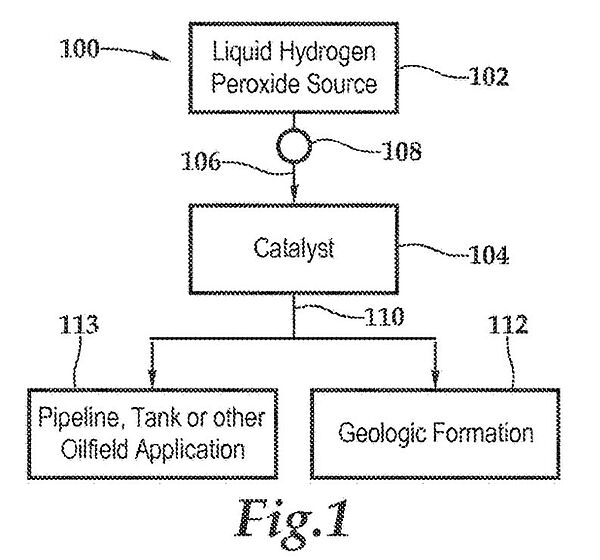
Image from: US20210262330A1
100 - apparatus for producing steam; 102 - liquid hydrogen peroxide source; 104 - catalyst; 106 - first conduit; 108 - pump; 110 - second conduit; 112 - geologic formation; 113 - other oilfield application.
Downhole steam generation
A method of downhole steam generation is proposed in patent CA2965902C published by Donaldson Engineering, Inc. (US). According to the method, a desired level of electrical conductivity for water to be converted to steam by passing an electrical current is determined first. Further, a main feedwater supply is acquired with an electrical conductivity level lower or higher than the desired level. A flow of sidestreams is then adjusted based on the conductivity of the feedwater and mixed with the feedwater to produce a resultant stream with an electrical conductivity of about the desired level. The sidestreams can comprise carbonic acid, sodium bi-sulfite, softened produced water, or can be passed through a reverse osmosis membrane, depending on the conductivity parameters of the feedwater. The resultant stream is pumped to the downhole location and electrical current is passed through the stream by employing "…electrodes with outlets of the resultant stream spaced therebetween".
The authors of the invention mention low efficiency caused by heat losses as the disadvantage of the existing solutions.
The patent is a part of a patent family comprising 5 documents published in the US, CA, and WO patent offices between 2015 and 2020.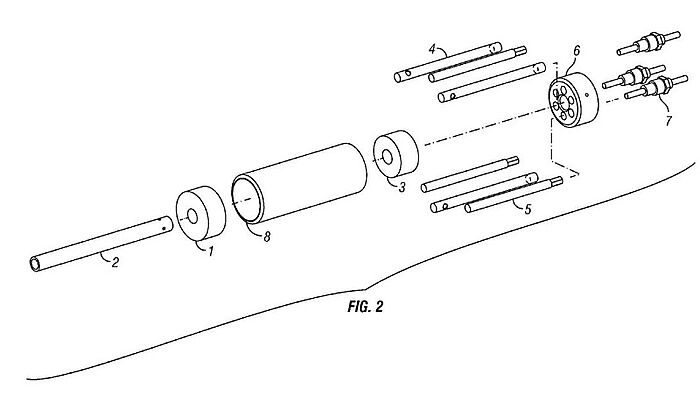
Image from: US9752422B2
1 - bottom closure or flange; 2 - outlet pipe; 3 - high temperature ceramic insulator; 4 - internal conduits or pipes; 5 - electrodes; 6 - top closure or flange; 7 - high pressure bulkhead connectors; 8 - outer cylinder or casing.
A downhole steam generation system and method are described in patent US9528359B2 by World Energy Systems Inc (US). The steam generator comprises a body with a bore operable to inject a first oxidant stream into a combustion chamber, fuel injectors to inject a first fuel stream, an igniter operable to inject a second fuel stream and a second oxidant stream. The igniter comprises a power source to initiate combustion of the mixture. The fuel injectors form two injection steps – in the first step an inner diameter is greater than an inner diameter of the bore, while in the second step an inner diameter is greater than that of the first step, and the second step is made downstream of the first step. The combustion chamber is formed by a liner coupled to the body and having fluid paths. According to the method, fuel and oxidant are supplied to the combustion chamber and flow through the igniter, which initiates combustion and water is injected to the combustion products to generate steam. Detailed operating parameters of the method are provided in the claims of the patent.
As the main disadvantages of the existing technical solutions, the authors of the invention mention reliability- and efficiency-related issues, such as excessive temperatures, corrosion, material failures, thermal instabilities, etc.
The invention belongs to a patent family comprising 6 patent documents published in 2013-2018 in the US, CN, CA, and BR patent offices.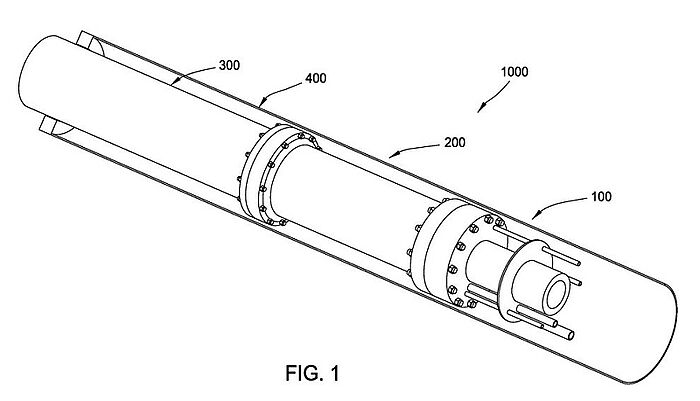
Image from: US9528359B2
100 - burner head assembly; 200 - liner assembly; 300 - vaporization sleeve; 400 - support sleeve; 1000 - downhole steam generation system.
Energy, gas or water consumption
Patent US11022299B2 by Babcock & Wilcox Canada, Ltd (CA) discloses a heat recovery steam generator (HRSG) boiler comprising a steam drum having a clean side and a dirty side. A clean downcomer pipe and a clean riser pipe are connected to the clean side. A dirty downcomer and a dirty riser pipe are connected to the dirty side. The clean pipes are connected to a clean steam generator bank located in a high heat flux zone, while the dirty pipes are connected to a dirty steam generator bank located in a low heat flux zone. Boiler water is fed from the clean side to the dirty side via natural head differential created by a baffle or weir, or by a configuration of pipes. The clean side is fed by feedwater from the economizer. The boiler further comprising a furnace having a plurality of membrane wall modules, each with an upper header, a roof, a wall, a floor, and lower headers connected to the floor, the roof, the wall and the floor, defining a fire box with an inlet end and an outlet end. The furnace also includes "…a membrane front wall connected to the upper and lower headers and being at the inlet end of the fire box". The inlet of the boiler is coupled to the hot exhaust gas and to the firebox inlet providing heat. The claims of the invention also define other configurations of the steam generator boiler.
The invention concerns the issues of water reuse in SAGD operation from both the environmental point of view and in relation to the power costs and equipment failures.
The invention is a part of a family comprising 6 patent documents published between 2017-2021 in WO, US, CA, and MX.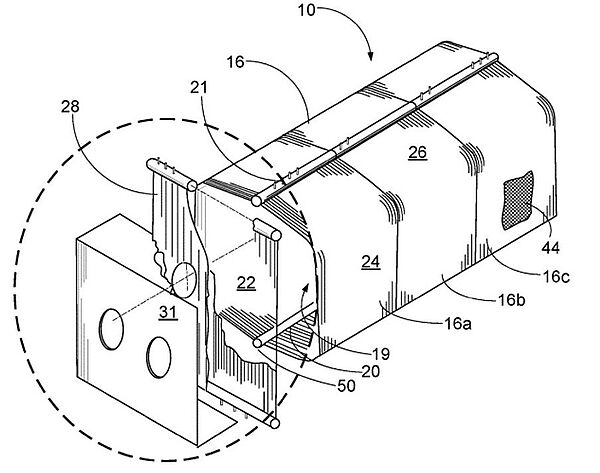
Image from: US11022299B2
10 - boiler; 16 - furnace; 16a,16b,16c - furnace steam generation surface modules; 19 - inlet; 20 - lower headers; 21 - upper headers; 22 - floor; 24 - wall; 26 - roof; 28 - front wall; 31 - windbox; 44 - insulation; 50 - drain.
The analysis of these and other technical solutions performed for this article shows that in the technologies of steam generation for unconventional oil production, the inventions propose highly-diversified approaches for a wide range of problems. At the same time, it can be seen that besides such generally recurring problems as Low efficiency of primary production and Energy, gas or water consumption, the problem related to material and equipment failures caused, for example, by contamination by solids or other residues in the feedwater, is a major concern for the inventors involved in this field.
More detailed information about inventions in the field of steam-assisted production of unconventional oil, and patent research methodology can be found on aenert.com and in UNCONVETIONAL OIL PRODUCTION. Steam Injection. Extended patent report. July 2022.
By the Editorial Board
